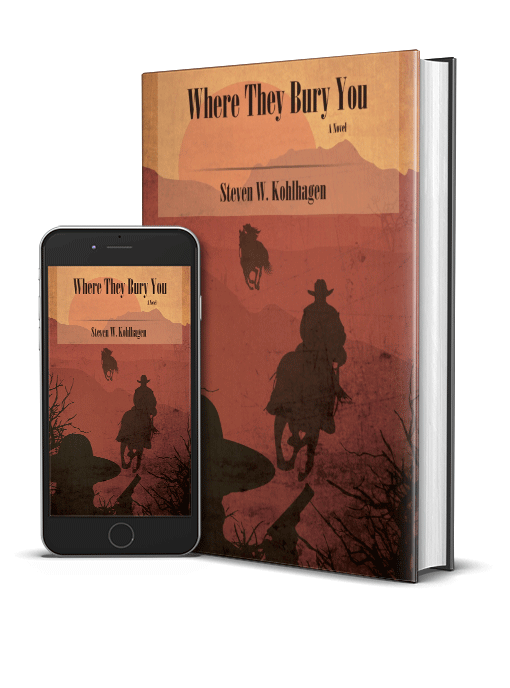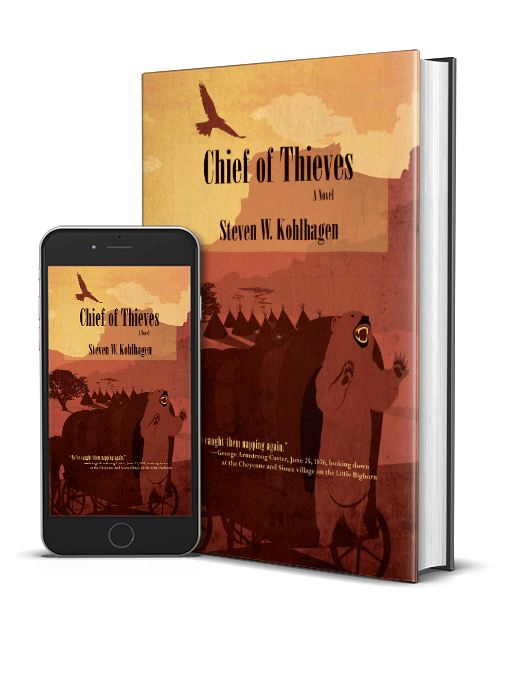Reviews for The Point of a Gun
“What happens when US Intelligence Agents take the law into their own blood-soaked hands? Steve Kohlhagen’s taut novel, told at breakneck speed, is a thrilling ride into terror, vengeance and moral ambiguity.” – Bernard Cornwell
***
“The Point of a Gun is a dystopian thriller that could very easily happen, and soon. Steven W. Kohlhagen’s taut and tense political action story lays bare the potential for terrorism, arguably the contemporary world’s greatest scourge, to dismantle American society with just a few more attacks.” —Foreword Reviews
***
“[This] is a book that might fulfill many reader’s wishes that someone out there would do what the government and law enforcement won’t, that is prevent terrorism before it happens by killing off those who would do us harm.” —Book Pleasures.com
***
“This book has so much action. You combine this with a great storyline and characters and you get a winning combination with an outcome called “The Point of a Gun.” —Cheryl’s Book Nook
***
“I found this book to be very fast paced and character driven, a real page turner…If you love a good political/mystery/thriller, then you will enjoy this book!” —Celtic Lady Reviews
***
“Get this book today, available via Kindle or paperback. I couldn’t put it down. It’s one for your #SummerMustReads list!” —Deb Hunter
***
“The book hits home on so many levels.” —Pick of the Literate
***
“Thoroughly Entertaining. I’d certainly recommend this book to anyone that enjoys a really good Action Thriller.” —Amazon 5-Star Review
***
“Kohlhagen’s novel, The Point Of A Gun, is a political thriller full of misdirection and cleverly laid clues.…would highly recommend it to anyone who likes conspiracy thrillers.” —Cheesy the Cat’s Bookshelf
Reviews for The Point of a Gun
Published by Sunstone Press
Edition Barenklau
“What happens when US Intelligence Agents take the law into their own blood-soaked hands? Steve Kohlhagen’s taut novel, told at breakneck speed, is a thrilling ride into terror, vengeance and moral ambiguity.” – Bernard Cornwell
***
More to come!
Reviews for Where They Bury You
“In this rough-and-tumble frontier story, endless layers of deceit up the ante and interest.” – Kirkus Reviews
***
“…Kohlhagen avoids all the traps and clichés of typical Westerns and keeps true to his story. All in all, Where They Bury You is a very impressive novel for fans of Westerns and even for those who are not fans of Westerns. It has a universal appeal. Definitely a quality read. 4.5 stars.” – Author-Alliance
***
“Steve Kohlhagen knows the West, knows his history, and combines them here into a fast-paced, irresistible story!” – Bernard Cornwell
Reviews for Where They Bury You
“In this rough-and-tumble frontier story, endless layers of deceit up the ante and interest.” – Kirkus Reviews
***
“…Kohlhagen avoids all the traps and clichés of typical Westerns and keeps true to his story. All in all, Where They Bury You is a very impressive novel for fans of Westerns and even for those who are not fans of Westerns. It has a universal appeal. Definitely a quality read. 4.5 stars.” – Author-Alliance
***
“Steve Kohlhagen knows the West, knows his history, and combines them here into a fast-paced, irresistible story!” – Bernard Cornwell
Reviews for Chief of Thieves
“Kohlhagen doesn’t shy away from the ugly history of the American West in this novel about white settlers in nineteenth-century Oregon and Wyoming.
Following up his work of historical fiction, Where They Bury You, Steven W. Kohlhagen continues the Wild West saga of Lily Smoot and Augustyn P. Damours, opening with the lovers traveling the wild frontier of Colorado to the Oregon Trail. But the pair are on the lam, fleeing New Mexico with almost $40,000 purloined from their con-artist cohort, Major Joseph Cummings, who has recently been shot dead.
Lily, ex-prostitute and poker dealer, and Augustyn, army lieutenant and card sharp now known as Gus Smoot, are headed for Washington Territory to take up ranching. Spanning 1863 to 1876, Kohlhagen’s narrative follows the couple through Colorado and Wyoming and on to Oregon. There they homestead, but Gus is no rancher, preferring to scout for the army. Lily relies on Joe Lincoln, an escaped slave, as ranch foreman. Dissatisfied with Oregon, Lily returns to Wyoming’s Chugwater Valley, lush grassland between Cheyenne and Laramie. Gus follows, but he remains restless, continuing scouting.
Kohlhagen uses meticulous research to blend historical and fictional characters. For example, Damours was an army lieutenant and general’s aide who mysteriously disappeared. Well-known figures appear—Crook, Custer, Black Kettle, and Sitting Bull—as well as seminal settlers like John Iliff, one of the region’s first ranchers. Kohlhagen also employs two Cheyennes found in historical documents, Antelope and Thunder Bull, for perspectives on tribal life and reactions to settler encroachment.
Not shying away from ugly history, Kohlhagen delves into the Sand Creek and Washita massacres, along with the hubris leading to Little Big Horn—all while focusing an empathetic eye on rough frontier justice. More than one rustler or thief dies, and an OK-Corral-style shoot-out ensues when a bounty hunter in pursuit of Gus confronts Lily and Lincoln.
The character development would be improved had Kohlhagen offered more backstory, especially in giving a clearer sense of the crime that financed the pair’s dream. That said, Lily is a character to root for—strong, independent, intelligent, and determined. That she loves Gus is evident, but the book fails to show interactions with her children. Gus is a maverick-style lovable rogue. African-American Lincoln hears the n-word, but Kohlhagen doesn’t delve deeply into the importance of blacks in western settlements.
More literary descriptions would give nuance, color, and depth. For example, ranchers hunt for winter food, houses are built, and there are days on the trail, but there’s little about how or what it required to survive day to day. Kohlhagen’s novel, with glossary, maps, and notes, has only minor editing flaws, and the author shows great familiarity with the west, its settlers, and Native Americans.
All in all, historical fiction fans will want to add this novel of the American West to their libraries.” – Gary Presley, Foreword Reviews
Disclosure: This article is not an endorsement, but a review. The author of this book provided free copies of the book and paid a small fee to have their book reviewed by a professional reviewer. Foreword Reviews and Clarion Reviews make no guarantee that the author will receive a positive review. Foreword Magazine, Inc. is disclosing this in accordance with the Federal Trade Commission’s 16 CFR, Part 255.
***
“I’ve been looking forward to Steve Kohlhagen’s next book and am not disappointed!” – Bernard Cornwell
***
“Kohlhagen uses (his) research to blend historical and fictional characters…and the author shows great familiarity with the West, its settlers, and Native Americans. All in all, historical fiction fans will want to add this novel of the American West to their libraries.” – Foreword Clarion Reviews
Reviews for Chief of Thieves
“Kohlhagen doesn’t shy away from the ugly history of the American West in this novel about white settlers in nineteenth-century Oregon and Wyoming.
Following up his work of historical fiction, Where They Bury You, Steven W. Kohlhagen continues the Wild West saga of Lily Smoot and Augustyn P. Damours, opening with the lovers traveling the wild frontier of Colorado to the Oregon Trail. But the pair are on the lam, fleeing New Mexico with almost $40,000 purloined from their con-artist cohort, Major Joseph Cummings, who has recently been shot dead.
Lily, ex-prostitute and poker dealer, and Augustyn, army lieutenant and card sharp now known as Gus Smoot, are headed for Washington Territory to take up ranching. Spanning 1863 to 1876, Kohlhagen’s narrative follows the couple through Colorado and Wyoming and on to Oregon. There they homestead, but Gus is no rancher, preferring to scout for the army. Lily relies on Joe Lincoln, an escaped slave, as ranch foreman. Dissatisfied with Oregon, Lily returns to Wyoming’s Chugwater Valley, lush grassland between Cheyenne and Laramie. Gus follows, but he remains restless, continuing scouting.
Kohlhagen uses meticulous research to blend historical and fictional characters. For example, Damours was an army lieutenant and general’s aide who mysteriously disappeared. Well-known figures appear—Crook, Custer, Black Kettle, and Sitting Bull—as well as seminal settlers like John Iliff, one of the region’s first ranchers. Kohlhagen also employs two Cheyennes found in historical documents, Antelope and Thunder Bull, for perspectives on tribal life and reactions to settler encroachment.
Not shying away from ugly history, Kohlhagen delves into the Sand Creek and Washita massacres, along with the hubris leading to Little Big Horn—all while focusing an empathetic eye on rough frontier justice. More than one rustler or thief dies, and an OK-Corral-style shoot-out ensues when a bounty hunter in pursuit of Gus confronts Lily and Lincoln.
The character development would be improved had Kohlhagen offered more backstory, especially in giving a clearer sense of the crime that financed the pair’s dream. That said, Lily is a character to root for—strong, independent, intelligent, and determined. That she loves Gus is evident, but the book fails to show interactions with her children. Gus is a maverick-style lovable rogue. African-American Lincoln hears the n-word, but Kohlhagen doesn’t delve deeply into the importance of blacks in western settlements.
More literary descriptions would give nuance, color, and depth. For example, ranchers hunt for winter food, houses are built, and there are days on the trail, but there’s little about how or what it required to survive day to day. Kohlhagen’s novel, with glossary, maps, and notes, has only minor editing flaws, and the author shows great familiarity with the west, its settlers, and Native Americans.
All in all, historical fiction fans will want to add this novel of the American West to their libraries.” – Gary Presley, Foreword Reviews
Disclosure: This article is not an endorsement, but a review. The author of this book provided free copies of the book and paid a small fee to have their book reviewed by a professional reviewer. Foreword Reviews and Clarion Reviews make no guarantee that the author will receive a positive review. Foreword Magazine, Inc. is disclosing this in accordance with the Federal Trade Commission’s 16 CFR, Part 255.
***
“I’ve been looking forward to Steve Kohlhagen’s next book and am not disappointed!” – Bernard Cornwell
***
“Kohlhagen uses (his) research to blend historical and fictional characters…and the author shows great familiarity with the West, its settlers, and Native Americans. All in all, historical fiction fans will want to add this novel of the American West to their libraries.” – Foreword Clarion Reviews
Steven W. Kohlhagen
Award winning author of contemporary terrorist thriller, mystery, and western novels. Former Berkeley Economics Professor and retired Wall Street Investment Banking Executive.
© 2017 Steven W. Kohlhagen. All rights reserved. Site by JKS Communications
SITE LINKS



